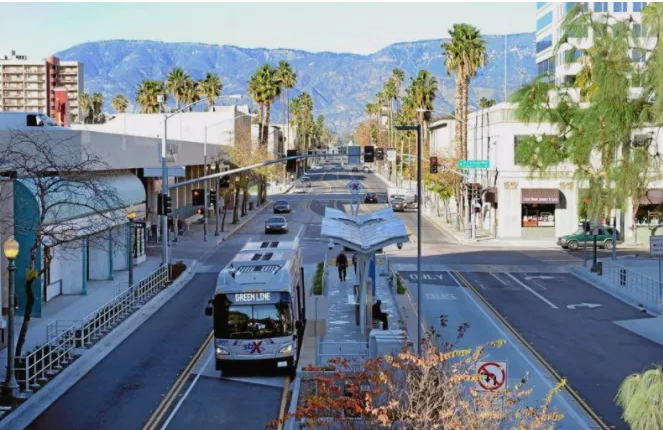Neighbors have come together over a "Beautiful Boulevard" proposal to put Metro Bus Rapid Transit (BRT) along a walkable Colorado Boulevard through the heart of Eagle Rock. Beautiful Boulevard enjoys a broad array of local support including businesses, community groups, parent-teacher associations, and others. The proposal got a boost this week when the area's Metro representative, L.A. County Supervisor Hilda Solis, expressed her support.
Metro's North Hollywood to Pasadena BRT project will be a ~18-mile-long new line extending from the B/G Line (Red/Orange) North Hollywood Station to the L Line (Gold) in Old Town Pasadena. The project will span four cities: Burbank, Glendale, Pasadena, and Los Angeles.
In 2019, the project weathered NIMBY criticism, especially in the northeast L.A. City neighborhood of Eagle Rock. In late 2020, Metro released the project's Draft Environmental Impact Report (DEIR) for public comment. The Metro board is expected to approve a final Locally Preferred Alternative in April, and to approve the project's final EIR later this year.
Responding to a Metro staff presentation at this week's Metro board Planning and Programming Committee, Supervisor Solis stated that she is "very excited about" and "on board with" the Beautiful Boulevard proposal. Solis described the proposal as "worthwhile," "futuristic," and "provocative." She praised it for addressing the needs of businesses, drivers, bus riders, pedestrians, and cyclists. [The BRT project presentation starts at 11:04; Solis' BRT comments start at 22:44.]
Metro staff stated that they plan to do a "technical review" of Beautiful Boulevard, as it includes "narrowing a traffic lane." Staff further stated that they intend to "incorporate elements [of Beautiful Boulevard] as best we can" into the project plan.
The new “Beautiful Boulevard” proposal is detailed at the Eagle Rock Forward webpage.
Eagle Rock homeowner and safe streets advocate Michael MacDonald stresses that "Angelenos should not have to choose between high quality transit or safe, walkable, and vibrant streets."
"In saving medians, providing quality transit service to Eagle Rock, supporting small businesses, mitigating traffic concerns, upgrading bike lanes, and maintaining curbside parking," MacDonald states, "the Beautiful Boulevard proposal thoughtfully addresses all of the primary priorities that were expressed by Eagle Rock community members that Metro reached out to during initial public meetings."
Unlike Metro’s one-size-fits-all options for Colorado (see below), the Beautiful Boulevard proposal is organized into three distinct zones, which originate in the 1992 Colorado Boulevard Specific Plan.
Splitting up the project into three sections allows BRT improvements to better fit into the local context.
Closer to freeways, Colorado is designed to accommodate more car traffic, while the central downtown area focuses more on walkability and safety.
Adjacent to the 2 Freeway and the Eagle Rock Plaza mall, Zone 1 sees the most traffic. In this area, the Beautiful Boulevard proposal maintains existing travel lanes, while incorporating new median-running bus lanes adjacent to new landscaped medians. Existing bike lanes would be maintained, but downgraded to non-buffered bike lanes.
Beautiful Boulevard's Zone 2 proposal accentuates the already walkable character of Downtown Eagle Rock. It retains existing medians and on-street parking, while upgrading existing bike lanes to a European-style raised version flush with sidewalks. BRT would run in dedicated bus lanes along the median. The proposal calls for additional landscaping, expanded sidewalks, ADA upgrades, raised crosswalks (along Colorado), and additional crosswalks across Colorado. For the downtown stretch, one car lane in each direction would be reallocated as a bus-only lane.
East of Downtown Eagle Rock, as Colorado approaches the 134 Freeway ramps, Beautiful Boulevard proposes retaining the existing two travel lanes, plus upgrading existing bike lanes to protected, and adding new landscaped medians.
The Beautiful Boulevard proposal could work with Metro's existing right-side boarding buses, but calls for utilizing left-side bus boarding at Colorado Boulevard stations. This practice makes for faster center-running buses, outside of the car-congested right lane. Left-side boarding is common on many U.S. BRT lines, including in San Bernardino, Oakland, Cleveland, Indianapolis, and Albuquerque. In the past Metro has been reluctant to utilize both-side-boarding buses. In December, the Metro board passed a motion directing staff to report back on the feasibility of utilizing left-side boarding on Metro BRT lines. Motion co-author Solis specifically noted that left-side boarding buses would benefit the Noho-Pasadena BRT project.
Beautiful Boulevard is a response to three flawed alternatives included in Metro's DEIR.
Metro freeway alternative "F3" is particularly anti-transit because it would keep BRT out of Downtown Eagle Rock. This alternative would route BRT on the 134 Freeway, with two noisy and polluted freeway-adjacent stations at Eagle Rock's periphery: on Harvey Drive in Glendale, and on North Figueroa Street near the Pasadena border. Metro's own studies show the freeway alternative would serve fewer destinations and result in lower ridership. For more background on the 134 Freeway route, see Equitable Eagle Rock's scathing critique.
Metro's two Colorado Boulevard alternatives offer Eagle Rock residents a Sophie's Choice decision: improve transit at the expense of losing medians, parking, walkability, and/or bikeways. Metro planners were unwilling to eliminate a travel lane for any portion of the project, which led to eliminating these other worthwhile features.
Both Metro alternatives would would revert Colorado Boulevard to six lanes, undoing the 2013 street improvements that gave Colorado its current four-lane configuration.
Metro’s center-running alternative "F1" would add new lanes to place BRT in the middle of Colorado Boulevard. This would largely eliminate existing landscaped medians (former streetcar right-of-way) in Downtown Eagle Rock. This alternative would also eliminate nearly half of existing curbside parking.
Metro’s side-running alternative F2 would put BRT in the right lanes of Colorado Boulevard. This alternative would eliminate Colorado's existing buffered bike lanes. Buses would experience minimal speed improvements as they would share the rightmost lane with cyclists, right-turning drivers, and parking drivers.
More details on the Beautiful Boulevard proposal can be found at Eagle Rock Forward, which includes informative sliding before/after images and an FAQ page. To support the proposal, visit the Take Action page.






